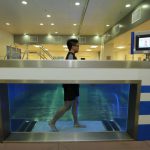Underwater treadmill
Back to previous pageUnderwater treadmill functionality
Exercising on an underwater treadmill combines the favourable effects of water during the execution of stationary walking exercises. An underwater treadmill turns the pool into a virtually endless pool; the patient does not have to turn at the end. Water has lots of favorable effects on the rehabilitation process. Because of the buoyancy, weight bearing in the legs is reduced, which makes it easier for an injured patient to exercise. At the same time, the warm water makes the ligaments more elastic and therefore range of motion is increased. As an added bonus, submersion in water reduces pain sensation.
All these effects added together makes the underwater treadmill an excellent piece of exercise equipment, that can be extremely useful for obesity treatment, sports endurance training and general rehabilitation of leg problems.